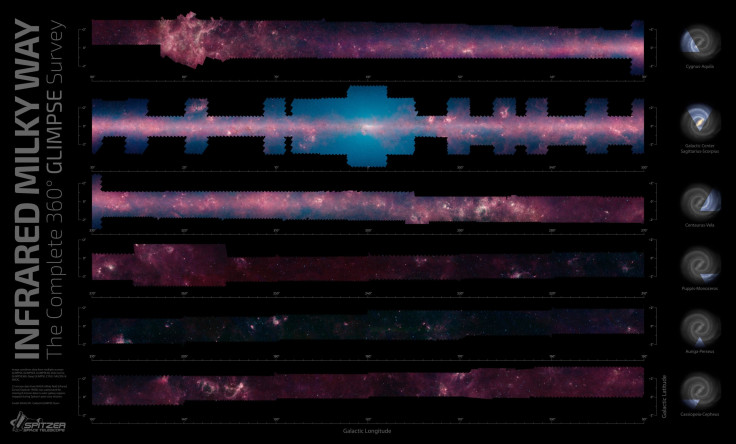NASA Interactive Panorama Of Milky Way Galaxy Is Big Enough To Fill A Football Stadium [PHOTO]
NASA has released a new panorama of the Milky Way galaxy that was created using two million photos over the course of 10 years. The result of this unusual project is a 360-degree view of the Milky Way that can be explored at home on your computer.

The team created the image from data collected by NASA’s Spitzer Space Telescope, which was launched in 2003, and was part of the Galactic Legacy Mid-Plane Survey Extraordinaire (GLIMPSE 360) project. The GLIMPSE 360 home page features two interactive panoramas of the Milky Way.
As noted by the researchers, the Milky Way is a flat spiral disk and Spitzer observed its plane, creating a panoramic image that features more than half of the stars in the galaxy. Over the course of 10 years, Spitzer has spent 172 days observing the plane of the Milky Way. Unlike other telescopes, Spitzer observes in infrared which cuts through all the dust that is found at the center of the Milky Way and provides researchers with new insights into the overall shape of the galaxy as well as where it ends.
Robert Hurt, an imaging specialist at NASA's Spitzer Space Science Center, said in a statement, “If we actually printed this out, we'd need a billboard as big as the Rose Bowl Stadium to display it.” For such a large image it’s easy to understand how a full-resolution poster is 306 MB while the raw data is even larger, clocking in at more than 6.4 GB over eight files.
There are two different browsing options, one using Microsoft’s WorldWide Telescope viewer that maps the Milky Way over the night sky while the CDS Aladin Lite Viewer lets users navigate to different points of interest, such as the Cat’s Paw Nebula, and export images.
According to NASA, the Spitzer images also lets researchers explore star formation activity, including the "bubble" that surrounds massive stars. The bubbles are caused by wind and radiation pushing away gas.
The GLIMPSE 360 project has led to a better map of the Milky Way, its central bar and the structure of the galaxy and has already revealed the Milky Way is larger than previously believed, reports NASA. For citizen scientists looking to help out, the Milky Way Project lets volunteers identify bubbles and other galactic features.
A video zooming into the Milky Way panorama can be viewed below. The 360-degree Milky Way image was presented at the TEDActive 2014 Conference on March 20.
© Copyright IBTimes 2025. All rights reserved.






















